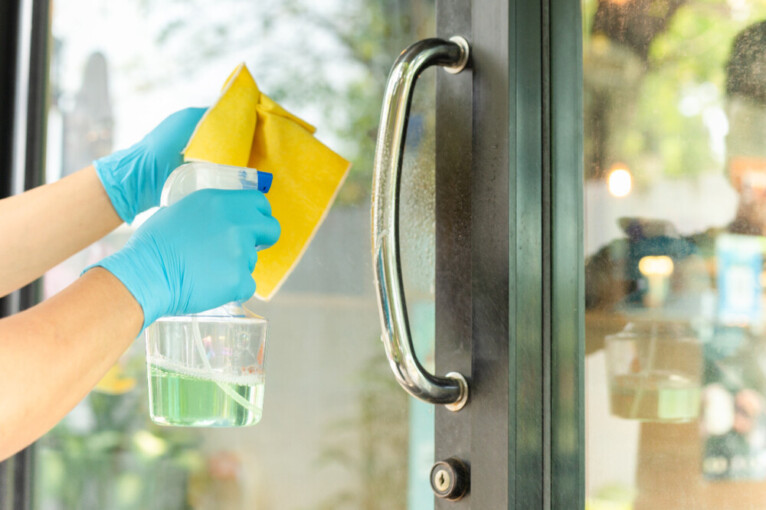
Maintaining self-hygiene is one way to break the chain of transmission of COVID-19. There are various methods such as using antiseptics to wash hands and body parts, also disinfectants that are rubbed or sprayed on inanimate objects that exposed to viruses.
However, at this time in the community, the phenomenon of massive disinfectant spraying appears in various places, even carried directly into the human body. UGM Pharmacy Faculty Researcher, Dr. rer nat., Endang Lukitaningsih, S.Sc., M.Sc., Apt., explained that disinfectants are chemicals used to inhibit or kill microorganisms such as bacteria, viruses, and fungi except for bacterial spores on the surface of inanimate objects such as floors, furniture, and room.
“Disinfectants are not used on the skin or mucous membranes because of the risk of irritating the skin and potentially triggering cancer. Disinfectant is different from antiseptics, it risked the skin surfaces and mucous membranes,” Endang said during an online press conference on Monday (6/4).
Disinfectants can also be used to clean the surface of objects by wiping the disinfectant solution on the contaminated part. For example, on floors, walls, elevator buttons, table surfaces, doors, and others. The use of disinfectants by spraying or fogging techniques used to control the amount of antimicrobial and viruses in high-risk rooms. UV light with a specific wavelength usually used in places that are difficult to reach. This process will prevent the transmission of pathogenic microorganisms from the surface of objects to humans.
Endang said if you want to use disinfectants, there are several products recommended for disinfection. For example, sodium hypochlorite, quaternary ammonium (a type of cationic detergent), 70 percent alcohol, and hydrogen peroxide. Nevertheless, she urged the public to always pay attention to the instructions for use on the label so that the product can be used safely and effectively.
“The concentration of disinfectants used needs attention. Besides the contact time between objects and disinfectants between 1-10 minutes depending on the type, and use gloves and ensure good ventilation to reduce exposure during use,” Endang explained.
Antiseptic
Endang explained that antiseptics are chemical compounds used to kill or inhibit the growth of microorganisms in living tissue, including the surface of the skin and mucous membranes. The aim is to reduce the chance of infection, sepsis, or decay.
Some antiseptics are true germicides that can destroy microbes. Others are bacteriostatic and only prevent or inhibit their growth. Disinfectants often used to clean wounds, sterilize hands before performing actions that require sterility, for example, povidone-iodine, potassium permanganate, hydrogen peroxide, and alcohol.
“Hand sanitizers generally contain antiseptics such as 60-70 percent alcohol. The levels of active ingredients in antiseptics are much lower than disinfectants,” she said.
How to Kill COVID-19
Another research team from Faculty of Pharmacy, Dr. Ika Puspita Sari, S.Sc., M.Sc., Apt., explained that the COVID-19 virus has a layer of viral walls composed of a glycoprotein cover that wraps RNA inside. So to kill the virus, it needs materials that can damage the shell and the material inside. This cover will not be destroyed with water alone, so WHO recommended that you will need another ingredient such as alcohol or soap.
In addition, is there any other material that can destroy the COVID-19 virus? Ika explained that Environmental Protection Agencies (EPA) had released 351 preparations that could be used as disinfectants to kill germs, including coronaviruses, with sufficient contact time.
One such preparation is ethanol with a minimum concentration of 60 percent. This concentration is known that it can dissolve the polar portion of the virus wall so that the virus will be damaged.
Besides, chlorine (chlorine dioxide, sodium hypochlorite, and hypochlorous acid) ingredients can kill viruses by entering through the walls of the virus and will damage the inside of the virus. Another example compound is benzalkonium chloride, which classified into the cationic surfactant. The compound is currently broadly used in disinfectant liquids. Even so, these two ingredients are volatile so that the risk of disrupting breathing if inhaled.
“There is also hydrogen peroxide, a powerful oxidizing agent that can damage the walls of viruses and the material inside. However, excessive use will irritate skin damage,” she said.
Disturb Ecosystems
While the Dean from the Faculty of Pharmacy, Prof. Dr. Agung Endro Nugroho, S.Sc., M.Sc., Apt., does not recommend spraying disinfectants directly on humans and living things. Besides being ineffective, it may disturb the ecosystem.
The use of a spray with a direct disinfectant in humans is also not recommended, except using a safe antiseptic liquid to protect parts of the body.
“For humans, prevention of transmission of the virus can be done by frequently washing hands using soap or hand sanitizers, maintaining healthy eating patterns and patterns of life to maintain immunity,” he said.
According to him, spraying disinfectants on the environment also needs to be reconsidered. People are encouraged to sufficiently spray disinfectant in particular areas. For example, rooms that require sterility in hospitals and rooms that have PDP.
“The best way to use disinfectants is to directly wipe on objects that are perhaps susceptible to the Cocud-19 virus,” he concluded.
Author: Ika
Translator: Natasa A

